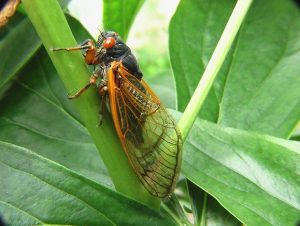Ready or Not! The “Brood X” Cicadas are Coming!!
- Esther M.
- May-05-2021
- Pest Control
Have you heard the latest development in the animal kingdom? Well, there is an insect that is fond of playing a sort of peek-a-boo game. In fact, they are so good at it that they are often forgotten when they go into hiding. These creatures are equally unique as they are strange, because they come out of hiding to mate, reproduce, and finally die. We’re keeping an eye out for these elusive creatures that are set to reappear this year. Read on to find out why you should too…
Meet the Cicadas

Most people don’t really know much about these insects. This is probably because they have perfected the art of appearing and re-appearing after several years. Here is a brief introduction to the mysterious insects…
You may have heard the buzz around “Brood X” of cicadas, but what exactly is a cicada? Cicadas are large, flying insects, typically known for the loud buzzing sound that males produce in order to attract female mates. These insects spend most of their lives underground and a small number of annual cicadas emerge each year. However, every so often, a massive number of periodical cicadas will all come up out of the ground at once, a sight that is hard to miss…
In 2021, Brood X, also known as the Great Eastern Brood, is set to emerge and be one of the largest in recent history, with billions of individual insects predicted to surface in 15 different states. Read more at Pest World…
Cicadas are often thought to be locusts, but this is not accurate. On the other hand, their habit of appearing in millions has often earned them a label as “a plague” or “a cloud”
Their Peculiar Life Cycle

There are two interesting facts about the life cycle of cicadas. First is that theirs is extremely long compared to other insects. Secondly, cicadas prefer the underground world compared to life above the earth’s surface. Here are some more details about these creatures…
The 13- or 17-year lifespan of periodical cicadas is one of the longest of any insect, but only a tiny fraction of that time is spent above ground. The rest of a periodical cicada’s life is spent underground as a nymph feeding on liquid sucked from plant roots. Over their many years beneath the soil, the nymphs shed their exoskeletons, a process known as molting, five times.
Writing for National Geographic, Amy McKeever reports that the nymphs count the years by detecting the uptick in fluid flowing through the roots they feed on that occurs during each year’s spring growing season. After 13 or 17 cycles, periodical cicadas wait for the soil temperature to reach around 64 degrees before digging their way back to the surface.
Once topside, the nymphs climb up into the trees where they proceed to plant themselves on a branch and transform into winged adults by once again shedding their exoskeletons. At first, the red-eyed adults are a ghostly white with soft, curled-up wings unfit for flight, but their bodies soon harden and turn black and the now rigid wings can finally float the chunky two-inch bug into the air. Read more at Smithsonian Magazine…
Whoa! That’s like living in your basement until you’re 17 years old! But once you’re out, you only have a month to live!
The Sounds They Produce

If their life cycle surprised you, then the intensity of the sound they produce will shock you! Cicadas can produce noises that could potentially harm your ears. When they come out in their numbers and begin calling out to each other, the sound could very well be compared to a rock concert!
Cicadas are also known for their buzzing and clicking noises, which can be amplified by multitudes of insects into an overpowering hum. Males produce this species-specific noise with vibrating membranes on their abdomens. The sounds vary widely, and some species are more musical than others. Though cicada noises may sound alike to humans, the insects use different calls to express alarm or attract mates. Read more at National Geographic…
The mechanism they use to produce this sound works just like a guitar. The vibrations created by their internal membranes are amplified by their hollow abdomens. Interestingly, the vibrations occur at light speed – 300-400 contractions per second! How about that, guitar players!?
As fascinating as these bugs are, their dependency on the sap of plants can damage gardent plants. So it’s best to consult the experts. At Backyard Bug Patrol, we are keeping an eye out for these interesting creatures. Get in touch with us for more information on how to protect your home through green pest control.
Related posts:
- Brood X Cicadas: They May Be Gone But The Memory of Their Presence Lingers On
- Three Practical and Everyday Benefits of Keeping a Pet (Includes Pest Control)
- The Types of Rodents That Carry The Hantavirus
- Did You Know You Can Use Dogs To Keep Rats Away?
- Three Reasons the Rare Brood X Cicadas Should Arouse Your Attention
